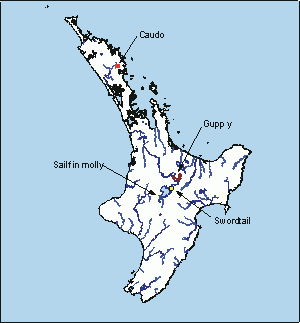Other live bearers (Phallocerus caudimaculatus, Poecilia latipinna, P. reticulata, Xiphophorus helleri)
In addition to mosquitofish, there are four other species of Poeciliidae in New Zealand. As all of these have a very restricted distribution, they have been combined for this discussion. They are all popular aquarium species (who has not heard of the guppy) and probably came to be released by aquarists either tired of looking after their fish or eager to establish feral populations in New Zealand. All except the caudo require warm water, and thus are unlikely to spread from their current locations in geothermal waters of the central North Island.
Caudo (Phallocerus caudimaculatus) Caudo were only recently discovered in New Zealand. The only known population occurs in stock water troughs near Whangarei, but the origins of this population are a mystery. They are thought to have come from a nearby stream, but no population can be found there today. The discovery of yet another illegally introduced fish in New Zealand is of concern because it is unknown what impact these fish might have on the ecology. Caudo do not require particularly warm water, and thus could easily spread to other parts of Northland.
Sailfin molly (Poecilia latipinna) As its name implies, the sailfin molly has a large dorsal fin. In male fish this can be twice as high as their body. Sailfin molly are only found at the southern end of Lake Taupo in the warm geothermal swamps around Tokaanu and Waihi, but are quite abundant there. Sailfin molly are one of the largest poeciliids in New Zealand with female fish known to reach 120 mm.
Guppy (Poecilia reticulata) Guppies are restricted to warm geothermal waters near Reporoa where they have probably been present since the 1920s. They closely resemble mosquitofish, although the male is more brightly coloured. Reaching a maximum length of 60 mm, guppies mature just a few weeks after being born. Like many live bearers, the female guppy can use sperm from one copulation to produce several broods of young.
Swordtail (Xiphophorus helleri) Feral swordtail in New Zealand are bright orange on the back and sides, a feature that distinguishes them from the other Poeciliidae. The lower part of the caudal fin in male swordtail is elongated into a tapering sword-like projection, hence the common name. They were probably only released in the last 15 years or so, and may eventually revert to the olive-brown colour typical of wild populations. They are only known to occur in Waipahihi Stream near Taupo. A survey of this stream in 1999 failed to catch any swordtail, and this population may now be extinct.

